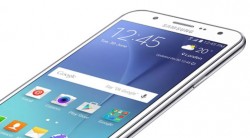 You may decide to install a custom recovery on your Samsung Galaxy J7 smartphone to use the NANDroid backup feature. While a new recovery isn’t the only way to use the NANDroid backup feature, anyone who plans on flashing new ROMs or kernels on the device will prefer using the options directly from the recovery so they can kill two birds with one stone. Most flashing should be done only after you have applied a factory reset form your recovery. Taking the NANDroid backup option from the recovery menu before you get that far is always the best option. You never know what might happen when flashing new ROMs or kernels so it’s always best to create a backup beforehand so you can restore that same backup if required. There are many pother ways to backup your device — the Helium application from your Google Play Store is always popular for anyone without root access. The focus usually changes to Titanium Backup once you have root permissions because it’s better. However, anyone installing a custom recovery might choose to use the NANDroid option over Helium and Titanium applications.
You may decide to install a custom recovery on your Samsung Galaxy J7 smartphone to use the NANDroid backup feature. While a new recovery isn’t the only way to use the NANDroid backup feature, anyone who plans on flashing new ROMs or kernels on the device will prefer using the options directly from the recovery so they can kill two birds with one stone. Most flashing should be done only after you have applied a factory reset form your recovery. Taking the NANDroid backup option from the recovery menu before you get that far is always the best option. You never know what might happen when flashing new ROMs or kernels so it’s always best to create a backup beforehand so you can restore that same backup if required. There are many pother ways to backup your device — the Helium application from your Google Play Store is always popular for anyone without root access. The focus usually changes to Titanium Backup once you have root permissions because it’s better. However, anyone installing a custom recovery might choose to use the NANDroid option over Helium and Titanium applications.
REQUIREMENTS
- You must have the SM-J700 model number of the Samsung Galaxy J7 smartphone to use this guide. Furthermore, you need to have an Exynos processor.
- You must have a Windows computer to use this guide because we will be using the Odin flashing tool.
BEFORE WE BEGIN
- You will find your device does not connect to the Windows computer in order to use the Odin flashing tool unless you enable the USB Debugging Mode on the Samsung Galaxy J7 smartphone first. You can turn on your USB Debugging on the J7 by tapping on the Apps > Settings > Developer Options > USB Debugging Mode.
- Any Galaxy J7 owner without the Developer Options unlocked can do that now by tapping on the Apps > Settings > About Device > Tap the Build Number continually until it counts you down with how many turns remaining until you are using the device as a developer.
HOW TO INSTALL TWERP RECOVERY ON SAMSUNG GALAXY J7 SM-J700 (EXYNOS SOC)
- Download the TWRP Recovery for the Galaxy J7 smartphone from here.
- Download the Odin flashing tool from here.
- Click the small triangle that is present on the right side of the download box on the bottom of your display after the files finish downloading on your computer.
- Choose to “open in folder”.
- Minimize your web browser and drag the files over to the desktop of the computer.
- Right-click on the files and choose to “extract here” on both of them.
- Check your desktop for the new files that have popped out after extraction.
- Double-click the Odin flashing tool and wait until it opens.
- Uncheck the Auto Reboot box that you can see from the Odin user interface and leave all the other settings as they are by default.
- Press the Power button on your Samsung Galaxy J7 smartphone and wait until it gives the option to switch off on your display; tap on the option to switch it off.
- Hold the Power + Volume Down + Home buttons in that order until it shows you the download mode text on the display.
- Press the Volume Up button when it tells you to do that on the display.
- Connect the Samsung Galaxy J7 smartphone to the computer with the USB cable.
- Look for a blue or yellow ID: COM port coming from the Odin user interface; no port means you need to install the Samsung USB Drivers and try again.
- Click the AP button or the PDA button from the Odin user interface and browse the desktop for your TWRP file.
- Click the Start button.
- Wait until you get a green box coming from the top left side of the Odin user interface with the pass message on display inside the box.
- Power down your smartphone by holding in the Power button and then choosing the Power off option from the display with your finger.
- Boot the Samsung Galaxy J7 smartphone by holding the hardware button combination for recovery mode (Power + Volume Up + Home) and then your recovery should be flashed properly on your device.
In conclusion, that’s how to install TWRP Recovery on Samsung Galaxy J7 SM-J700 smartphones using the Odin flashing tool and a Windows computer.

 Email article
Email article



